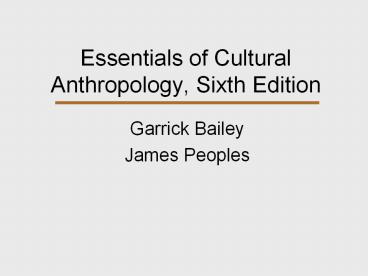Essentials of Cultural Anthropology, Sixth Edition - PowerPoint PPT Presentation
Title:
Essentials of Cultural Anthropology, Sixth Edition
Description:
Essentials of Cultural Anthropology, Sixth Edition Garrick Bailey James Peoples Chapter 1 The Study Of Humanity Chapter Outline Subfields of Anthropology Cultural ... – PowerPoint PPT presentation
Number of Views:181
Avg rating:3.0/5.0
Title: Essentials of Cultural Anthropology, Sixth Edition
1
Essentials of Cultural Anthropology, Sixth Edition
- Garrick Bailey
- James Peoples
2
Chapter 1
- The Study Of Humanity
3
Chapter Outline
- Subfields of Anthropology
- Cultural Anthropology Today
- Understanding Human Cultures Anthropological
Approaches - The Value of Anthropology
4
Subfields of Anthropology
- Archaeology
- Biological (Physical) Anthropology
- Cultural Anthropology
- Anthropological Linguistics
- Applied Anthropology
5
Archeology
- Investigating the human past by excavating and
analyzing material remains. - Prehistoric archaeology investigates cultures
that lived before the development of writing. - Historic archaeology investigates written
accounts along with historic sites.
6
Biological Anthropology
- Investigates
- Anatomy and behavior of monkeys and apes.
- Physical variations between different human
populations. - Biological evolution of the human species.
- Primatology is the study of evolution, anatomy,
social behavior and adaptation of primates.
7
Biological Anthropology
- Human VariationHow and why populations vary
physically. - PaleoanthropologyHow and why humans species
evolved. - Forensic AnthropologyAnalyze and identify human
remains.
8
Cultural Anthropology
- The study of contemporary and historically recent
human societies and cultures. - Focus on the customs and beliefs of a human
group.
9
Cultural Anthropology Objectives
- Study how groups of humans lived.
- Compare cultures to determine universal
principles. - Understand how dimensions of human life relate
(religion, art, communication, family). - Understand cultural change.
- Make the public aware of cultural differences.
10
(No Transcript)
11
Fieldwork
- Moving into the community under study,
communicating in the local language and living in
close contact with the people.
12
Ethnography
- A written account of how a single human
population lives.
13
Anthropological Linguistics
- How is language used in social contexts?
- What styles of speech do people use?
- What do the labels people attach to the
environment tell us about the the way they
perceive the environment?
14
Anthropological Linguistics
- Concerned with the complex relations between
language and other aspects of human behavior and
thought.
15
Applied Anthropology
- Applies research skills to human problems.
- Medical anthropology - health, nutrition, social
environment and cultural beliefs. - Development anthropology - helps agencies adapt
projects to community needs.
16
Applied Anthropology
- Applies research skills to human problems.
- Educational anthropology - deals with issues of
learning and teaching. - Corporate anthropology - trains employees within
a company what to expect and how to speak and act
when they conduct business in other countries.
17
Cultural Anthropology Today
- Research is often done in urban, industrial
areas. - Extended fieldwork continues to distinguish
cultural anthropology from other disciplines. - Research extends across many disciplines (law,
music, religion, etc.).
18
Globalization
- The effect on cultures of
- intermixing and migrations of peoples with
diverse homelands - multinational reach of communications media
- movement of production and services to overseas
locales - increase in international travel and tourism.
19
Anthropological Perspectives
- Holistic -No dimension of culture can be
understood in isolation. - Comparative - Generalizations about humans must
consider the range of cultural diversity. - Relativistic -Cultures cannot be evaluated based
on the standards of another culture.
20
Cultural Relativism
- No culture is inherently superior or inferior to
any other culture.
21
Ethnocentrism
- The belief that moral standards, manners and
attitudes of one's own culture are superior to
those of other cultures.
22
Value of Anthropology
- Allows us to see the development of human biology
and culture over time. - Provides knowledge about human evolution,
prehistoric populations, and tribal societies.
23
Value of Anthropology
- Encourages understanding and tolerance among
citizens of different nations. - Allows us to compare our lives with those of
people living in different times and places.
24
Quick Quiz
25
1. Anthropology has how many subfields?
- just one
- three
- five
- six
26
Answer c
- Anthropology has five subfields archeology,
biological or physical anthropology, cultural
anthropology, linguistic anthropology, and
applied anthropology.
27
2. Paleoanthropologists study
- our closest living relatives, the chimpanzees
- people such as the Asmat from New Guinea
- the aged
- our fossil ancestor
28
Answer d
- Paleoanthropologists study fossils to determine
how our species evolved.
29
3. Primatologists study
- plant pollen
- monkeys and apes
- prehistoric people and their sites
- the social context of language
30
Answer b
- Primatologists study monkeys and apes.

